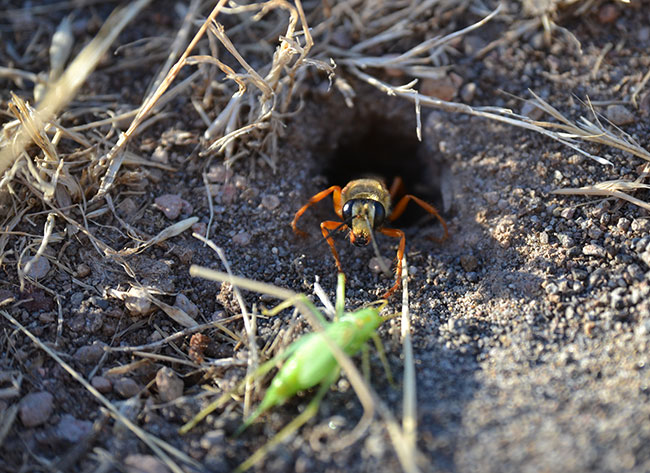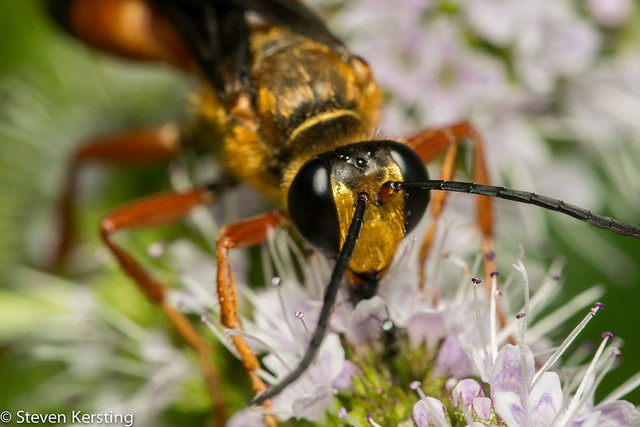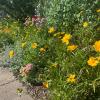With a daughter who is active in lacrosse, I find myself spending a lot of time hanging around sports fields, whiling away hours as she practices. Recently at such a practice, I wandered the field edges of a suburban high school, looking for signs of insect life. We’d been to this school before and I’d been pleasantly surprised to discover that the grass hadn’t been mowed on the banks between fields and buildings, allowing red clover and other flowers to bloom. I’d not previously observed anything spectacular, but I’d seen several species of bumble bees foraging and had found bees nesting in the ground where the grass was worn away by corner-cutting students. This evening, however, I found something far more interesting.

In a sandy patch beside a softball field were a number of holes, each with a distinct scattering of excavated dirt. The size of the holes was striking, three-quarter inch in diameter, much larger than those of the ground-nesting bees nearby. I figured that it was likely created by a wasp, one that had captured large prey such as a grasshopper. Intrigued, I sat down to wait for the occupant to return.
My patience was quickly rewarded. Within a few minutes a wasp flew in clutching a tree cricket as big as itself. I had stumbled upon a nesting aggregation of great golden digger wasps (Sphex ichneumoneus). This was a “lifer” for me, the first time I had seen this wasp, and it lived up to its name. The hair on its head and thorax was shimmering gold and it was big, more than an inch long.

Over the summer I had read J. Henri Fabre’s The Hunting Wasps, in the translation by Alexander Teixiera de Mattos published in 1917. It’s a fascinating book that recounts Fabre’s field observations and discoveries about several ground-nesting wasps in southern France, mainly during the second half of the 19th century. One of the species he wrote about was the yellow-winged sphex (Sphex flavipennis), which preyed on crickets, and during my time on this school field I saw the same behavior that Fabre described for his sphex: On arrival, the wasp placed the prey just outside the entrance, and then went into burrow for a few seconds, before reappearing to grab the prey and move it into the nest. Why it does this isn’t entirely clear. Is it checking for a tunnel collapse or maybe making sure there wasn’t another insect laying eggs in its nest?
The tree crickets being moved into the nest are not dead, but immobilized. A dead cricket would rot in the nest; paralyzed, they remain fresh for a week or two before the larva consumes them. It was Fabre who discovered the precision with which wasps sting their prey. The yellow-winged sphex used three stings to immobilize a cricket, apparently carefully placed in nerve centers. After turning the cricket on its back and holding its legs, the sphex stung it in the throat to immobilize the mandibles (which could bite the wasp or its offspring), then one sting in the front of thorax (to disable hind legs that could kick or dislodge the larva), and the third in the abdomen. It was likely that the digger wasps on this school field applied the same technique.

All of this passed through my mind as I watched the wasps returning again and again with crickets for their offspring, a connection that spanned continents and centuries. I was also struck by how seemingly mundane places can support such remarkable wildlife. This was no wildlife refuge, just a school field surrounded by suburbia. Our towns and cities can—should—be rich in insect life. When thoughtfully cared for, gardens, school, parks, and other greenspaces have a role to play in ensuring we all have the opportunity for such an encounter.



